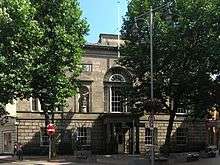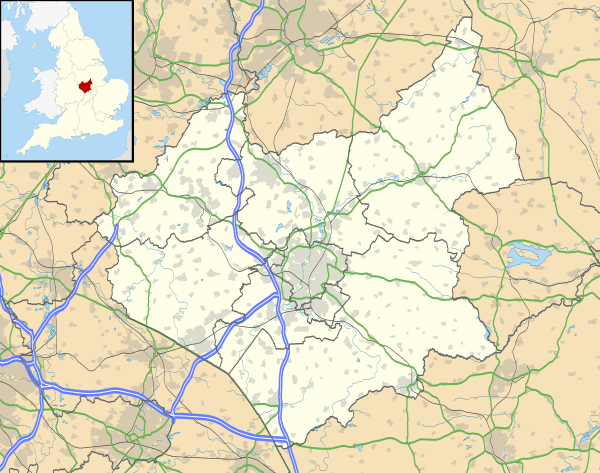The City Rooms (Leicester)
The City Rooms is located in the heart of the City of Leicester in England. It has been designated by English Heritage as a Grade I listed building.[1]
| The City Rooms | |
|---|---|
 | |
| Location | Leicester, Leicestershire, England |
| Coordinates | 52.6337°N 1.1342°W |
| Built | 1800 |
| Architect | John Johnson |
| Architectural style(s) | Greek Revival style |
| Website | www.thecityrooms.co.uk |
Listed Building – Grade I | |
| Official name: Assembly Rooms (County Rooms) | |
| Designated | 1950 |
| Reference no. | 1184114 |
 Location of The City Rooms in Leicestershire | |
History
The building, which was designed by John Johnson in the Greek Revival style, was completed in 1800.[2] It would have become Leicester's first hotel but was not completed as such and the building was sold in 1799 with £3,300 still needed to complete it.[2] It opened as the Leicester Assembly Rooms in 1800 and was used for the first time on 17 September to house the visitors to the Leicester Races held at Victoria Park.[2] The ground floor was used as a coffee house and the upper floors was used for wedding receptions, banquets and balls. In 1817 it was adapted to become the Judges' Lodgings when it passed into the hands of the County Justices, then becoming known as the County Rooms.[2] Following the implementation of the Local Government Act 1888, which established county councils in every county, it also became the meeting place of Leicestershire County Council.[3][4]
After County Hall was completed in 1967, the County Council had limited use for the building and, after it was sold to Leicester City Council in 1986, it became known as The City Rooms.[5]
The ballroom which runs the whole width of the building on the first floor is the centrepiece. Decorated with paintings by Ramsay Richard Reinagle and figures in niches on the front of the building by John Charles Felix Rossi, representing the comic and lyric muses.[2]
Outside in Hotel Street there is the statue of the Seamstress, although not intended to represent any particular person, it serves as a reminder of the importance the hosiery industry once played in Leicester. The Seamstress is shown putting a seam into a stocking and was sculpted by James Butler in 1990.[6]
In 2005 The City Rooms received a careful two year restoration to bring the building back to life as a hotel with highly decorated meeting rooms, a grand ballroom, a bar and four luxurious bedrooms.[7]
References
- Historic England. "Assembly Rooms (County Rooms) basement area railings to Assembly Rooms (County Rooms) (1184114)". National Heritage List for England. Retrieved 31 January 2015.
- Simmons, Jack (1949) "Notes on a Leicester Architect: John Johnson (1732-1814)", LAHS Transactions, Volume XXV, Leicestershire Archaeological and Historical Society, retrieved 2010-03-04
- "Local Government Act 1888". Legislation.gov.uk. Retrieved 17 August 2019.
- "Leicester Birth & Baptism Records". Forebears. Retrieved 8 September 2019.
- "City Rooms". Story of Leicester. Retrieved 8 September 2019.
- "The Leicester Seamstress". Statues. Retrieved 8 September 2019.
- "History". The City Rooms. Retrieved 8 September 2019.
External links
| Wikimedia Commons has media related to The City Rooms, Leicester. |